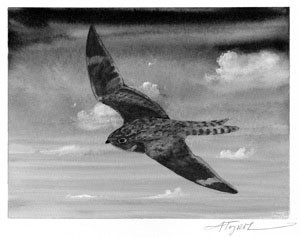
Several decades ago, after long hours of work in the carrels of Dartmouth’s Baker Library, I would make time for a walk around the library’s illuminated clock tower to view the aerial carousel of common nighthawks. In and out of the floodlights, they dipped and veered to feed on the wing, uttering an occasional peent.
This mesmerizing display was even sweeter because I knew each “mosquito hawk” was consuming more than 500 mosquitoes a night. Flying ants are also on the menu, comprising up to one-quarter of their food. (Biologists once dissected a nighthawk with 2,175 ants in its stomach.) Beetles are their next-most-popular prey, along with grasshoppers, locusts, woodborers, sawyers, plant lice, leaf chafers, weevils, and of course, those mosquitoes.
Once found throughout most of North America, these insectivorous machines are now rarely seen. Most likely, it isn’t a continental or global issue that has decimated northern New England’s populations; rather, nighthawks may have been inadvertently harmed as the gravel rooftops on older buildings have been renovated and replaced.
During the past 150 years, nighthawks in our region adapted so completely to flat, gravel-topped roofs in place of natural nesting grounds that they came to depend on these structures to survive. Nighthawks began nesting on warehouse rooftops in Philadelphia as early as 1869, and on the Mansard roofs of Boston in 1874. But, in recent decades, nighthawks have disappeared as old gravel roofs have been supplanted with rubber membranes and other contemporary roofing materials.
The jury is still out on the roof theory, and other possible reasons for the nighthawk’s decline include destruction of natural nesting habitat, problems during migration, or disruptions to their wintering grounds in Argentina and Paraguay. The use of pesticides to control insects may have reduced food supplies or poisoned the birds. An increase in predators, such as raccoons and skunks, may also be contributing.
In recent field studies for the Vermont Breeding Bird Atlas, the common nighthawk was one of 14 species whose nests were not confirmed, even though their nests had been observed in Vermont during earlier surveys conducted from 1977 to 1981. Twenty years ago, nighthawks nested in at least 16 New Hampshire towns, including Berlin, Claremont, Concord, Franklin, Keene, Manchester, Newport, and Tamworth. By 2006, nests were spotted only in Keene and Concord.
It was not always so. Nighthawks naturally nested on gravel banks, rock outcrops, and beaches. They laid eggs in plowed fields and corn stubble, on tree stumps, and even on fence posts. Their propensity for nesting on bare ground following forest fires earned them the nickname, “burnt-land bird.” Perhaps it was the relative safety that caused their gradual shift to nesting on gravel rooftops.
Safety does not appear to be a priority, however, during a male nighthawk’s daredevil mating ritual. He plummets from the sky toward a chosen female on the ground, only to apply feather brakes and swoop up just before crashing. The resulting rush of compressed air created by his primary feathers makes a “booming” sound. After mating, females brood two cream-colored eggs sporting granite-like flecks of color: dark brown and black to olive, gray, lilac, and lavender. Eggs are so well camouflaged that, if you ever discover a nest, don’t look away or it will be difficult to find again.
Females incubate the eggs, but males help feed and protect the young. When nests or chicks are threatened, nighthawks draw off intruders by feigning injury and moving from the nest. That failing, they fan their wings and tail feathers, stand their ground, and hiss.
Humans are coming to the defense of nesting nighthawks. Researchers at Cornell’s Laboratory of Ornithology and Kansas State University, who are studying nighthawk nesting behavior, are placing gravel nest patches on the sprawling flat roofs of “big box” stores where nighthawks once nested. Volunteers for New Hampshire Audubon’s “Project Nighthawk” have created several gravel patches on flat rooftops in Keene and Concord in the hopes that resident nighthawks will nest there.
Lou-Anne Conroy, Project Nighthawk’s volunteer coordinator for the Upper Connecticut Valley, recalls, “In September of 2007, I saw nighthawks flying over and realized I hadn’t seen them in 15years. I really miss seeing them.” Conroy worked with Roy Van Vleck and Robbie Harlow of the Lyme Timber Company to place two gravel nest patches this spring on their office roof at 23 South Main Street in Hanover. Other rooftop nest patches in Hanover are now on the Bank of America building and the town offices.
If the new nesting sites prove successful, we will have a better understanding of how nighthawks can be returned to the skies of New Hampshire and Vermont. And next time I’m in Hanover, I may once again witness the crepuscular flight of the nighthawk by the lights of Baker’s clock tower.


Discussion *